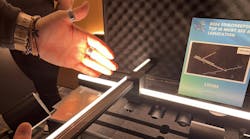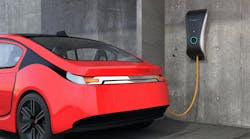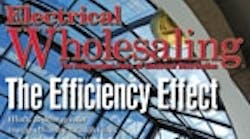In all the talk about green energy, most of the attention gets sucked up by power generation technologies — the photovoltaic panels and concentrating towers and wind turbines and such. It's exciting, it's sexy, and it looks like the future.
But even looking a decade into that future, it doesn't seem likely that the typical electrical distributor will be involved in solar and wind projects in any significant way as a percentage of revenues. Energy efficiency, on the other hand, is in most distributors' sweet spot and always will be, though the challenge of making the case for investing in new higher-efficiency technologies will continue to depend on skillful selling and a sure grasp of the technology as well as local codes and incentives.
According to a 2009 study by the National Academy of Sciences, the National Academy of Engineering and the National Research Council, however, it's not the leading-edge technologies that make the difference.
“A review of the best-performing new buildings in the country suggests that buildings that achieve energy use reductions of 50 percent or more below standard practice do not typically incorporate ‘cutting edge’ technologies, but rather they successfully integrate multiple ‘state-of-the-shelf’ technologies to achieve these performance levels. This represents a huge opportunity for improved energy performance using existing, available technologies.”
That study, titled “Real Prospects for Energy Efficiency,” points to the importance of increasing the energy efficiency of buildings: “The full deployment of cost-effective, energy-efficient technologies in buildings alone could eliminate the need to add to U.S. electricity generation capacity.”
To push U.S. commercial buildings toward that full deployment, there are quite a few efforts underway to revise building codes and promote changes in the way buildings are designed, constructed and operated. Here's a roundup of some of the more interesting recent developments in efforts to drive further efficiency in “the built environment.”
Commercial Building Codes
The International Code Council, a Washington, D.C.-based organization that develops commercial and residential building codes and standards used by many state and local governments, has been working hard on integrating energy-efficiency principles into its model codes and announced significant progress over the past couple of months.
The group (made up primarily of local and state building code officials) adopted revisions to its 2012 International Energy Conservation Code (IECC) in late October that will raise the bar for energy efficiency in commercial buildings. The revised code cuts energy use by 30 percent compared to the technologies specified in the 2006 IECC. The changes were proposed by a coalition led by the U.S. Department of Energy (DOE), the New Buildings Institute (NBI) and the American Institute of Architects (AIA).
Most of that 30 percent in savings comes from new requirements on heating, ventilation and cooling (HVAC) and building-envelope specifications, but there is some electrical impact that distributors and reps in cities where the code is used will want to be aware of. The changes include requirements that commercial buildings with a window-to-wall ratio over 30 percent must have daylight zone controls, and requirements for skylights or other daylight sources in spaces greater than 10,000 square feet for certain types of buildings. The revisions also include a new compliance option allowing the builder to choose between high-performance lighting, high-performance HVAC equipment or onsite renewable power generation in meeting the code's requirements for energy conservation.
These changes are in addition to the electrical requirements of the existing code (the 2009 IECC), which cover everything from lighting system controls to the connection of ballasts, maximum lighting for interior applications and minimum lighting for exterior applications. For example, the 2009 IECC requires dimming systems in any areas with walls or floor-to-ceiling partions. Each area that is required to have a manual control “shall also allow the occupant to reduce the connected lighting load in a reasonably uniform illumination pattern by at least 50 percent.”
Methods specified include controlling all lamps or luminaires; dual switching of alternate rows of luminaires, alternate luminaires or alternate lamps; switching the middle lamp luminaires independently of the outer lamps; or switching each luminaire or each lamp.
Requirements also cover time clock controls, occupancy sensors or automatic daylight controls, photosensors or astronomical time switches on outdoor lighting, limitations on the energy consumption of exit signs and requirements that buildings with multiple dwelling units have separate meters for each unit.
Most of these requirements have some exceptions, and there are some very specific limitations on certain parameters, such as the lighting power allowed for various applications. For example, the lobby of a motion picture theater is allowed 1W of lighting per square foot while a performing arts theater lobby is allowed more than three times that power (3.3 W/ft2), and the lobby of a religious building is limited to 0.6 W/ft2. Any distributor or rep selling into a market that adopts the IECC should dig into section 505 of the code and learn all its electrical requirements.
For cities and states that want to be closer to the leading edge of green building, the ICC introduced public version 2.0 of its International Green Construction Code (IGCC) at the USGBC's Greenbuild conference in Chicago last month.
IGCC is a model code promoting construction practices that maximize efficiency and minimize environmental impact, given existing technologies and practices. It seeks to set a standard for what can be considered a “high-performance green building.” This is a much more aggressive code than the IECC, as the new requirements of the 2012 IECC form the baseline standard for development of the IGCC.
The IGCC includes requirements for a much broader scope of parameters, including site selection and development, materials used (including techniques such as plastered straw bales, which have special wiring requirements), atmospheric quality, water conservation and renewable energy systems.
Among the electrical system components, the IGCC specifies limits on the amount of mercury that can be contained in fluorescent tubes. It includes specific metering requirements to allow building owners or managers to isolate and measure, report or display energy usage according to load type — be it HVAC, lighting, building operation, plug loads or process loads — as well as automated demand response capabilities. It also includes requirements for transformer efficiency, and minimum performance parameters for a variety of appliances and equipment.
At the time of last month's Greenbuild conference, only Richland, Wash., had already voted to adopt the IGCC as a building code, but ICC officials said many other jurisdictions were actively considering adoption. The final 2012 IGCC is scheduled for release in March 2012, after additional rounds of comments and proposed changes.
Zero-Energy Buildings
At the further reaches of building efficiency, the folks out in California are pushing for buildings that consume no energy. The California Public Utilities Commission (CPUC) in September introduced an action plan designed to help commercial building owners take advantage of the latest technologies and financial incentives to reduce energy use to ‘net-zero.’
The Zero Net Energy Action Plan identifies specific actions and timelines to achieve time-specific milestones in California's Energy Efficiency Strategic Plan. The plan aims to transform the state's commercial buildings into clean energy powered, energy-efficient structures by 2030, said CPUC Commissioner Dian Grueneich.
Zero net energy (ZNE) buildings have a net energy consumption of zero over a typical year. On-site solar, wind and other renewable energy resources generate the amount of energy used by the building. To date, California has more ZNE buildings than any other state in the nation. Technologies needed to achieve ZNE — including high-performance lighting and distributed generation such as rooftop solar — are widely available and incentivized.
The action plan lays out a path to implement California's Long-Term Energy Efficiency Strategic Plan for the commercial sector, published in 2008, which specified ZNE in two of the four “Big Bold Energy Efficiency Strategies (BBEES)” identified by the state:
-
All new residential construction in California will be ZNE by 2020
-
All new commercial construction in California will be ZNE by 2030
-
Heating, ventilation and air conditioning (HVAC) will be upgraded to ensure that its energy performance is optimal for California's climate
-
All eligible low-income customers will be given the opportunity to participate in the low-income energy efficiency program by 2020.
CPUC rolled out the lighting chapter of this strategic plan in September, outlining ways to cut lighting energy use statewide by 60 to 80 percent over the next decade.
Lighting accounts for approximately a quarter of California's electricity use and CPUC sees promoting the widespread use of energy efficient lighting as a route to significant savings. The lighting chapter of the Strategic Plan focuses on development and dissemination of best practices; expanded and enhanced research, development and demonstration infrastructure; cultivation of end-user demand; and integrated, supportive state policies.
“The lighting chapter is a comprehensive strategy to bring together all aspects of the lighting market in California to achieve the state's energy efficiency and zero net energy goals,” said Grueneich in announcing the lighting plan's adoption. “By coordinating public policy and regulations, building designers, owners, managers, occupants, consumers and technology developers can make best practices in energy-efficient lighting common practice.”
The lighting plan as yet doesn't include government mandates for changes in lighting, but leans instead on public outreach and education, supported by expanded research and development, plus the development of incentives to “to encourage best practices, enhancing coordination among regulatory agencies and creating more effective financing mechanisms for lighting retrofits.”
However, the near-term implementation plan — steps to be taken in 2010-2012 — include proposals to “align lighting-related codes and standards, green building rating systems and industry norms and practices with ZNE policy.”
The plan also calls for an end to existing programs encouraging Californians to swap their incandescent lamps for compact fluorescents (CFLs), and to shift incentives toward “the next generation of high-efficiency lighting.”
Beyond California, there are a number of efforts toward ZNE commercial construction underway. NEMA has been working with the Zero Energy Commercial Buildings Consortium, which hopes to make all commercial buildings in the U.S. ZNE by 2050. Created by the Zero Net Energy Commercial Buildings Initiative (CBI) as part of the Energy Independence and Security Act passed by Congress in 2007, and backed by the DOE, this public-private consortium seeks to “transform the commercial buildings sector into one that routinely builds zero-energy buildings for every type of use.”
LEED for Retail
The U.S. Green Building Council (USGBC) has been the most visible force for promotion of high-efficiency buildings through its Leadership in Energy and Environmental Design (LEED) rating system. The USGBC has continued to revise and refine its ratings over the time since LEED's introduction in 1998.
The most recent change has been the introduction of LEED rating systems specific to retail buildings. The two “LEED 2009 for Retail” rating systems — one for new construction and major renovations and another for commercial interiors — have been in development through pilot projects since 2005, and were approved by USGBC in March.
Among LEED for Retail's requirements is to, “provide individual lighting controls for 90 percent (minimum) of retail employees in office and administrative spaces, enabling adjustments to suit individual task needs and preferences.”
Building Information Modeling (BIM)
Building information modeling (BIM) software has been around for many years now, but use of the systems has seen a surge in adoption for construction and management of all kinds of buildings. The technology holds the promise of bringing substantial improvements in efficiency, not just in the construction process but throughout the whole lifecycle of a building.
The “Real Prospects for Energy Efficiency” study mentioned earlier points out the energy-saving potential of improved information flow in the design and construction process: “The main difference between high performing buildings and conventional buildings is essentially an attention to integration, interaction, and quality control throughout the design, construction, and operation of the building.” BIM systems are a tool for making such integration possible.
The electrical industry is playing a key role in shaping the next generation of BIM applications. The National Electrical Manufacturers Association (NEMA) has been working with the buildingSMART alliance, a council that's part of the nonprofit National Institute of Building Sciences (NIBS), which is working to develop open standards for data transfer among building industry software applications. The alliance's goal is “to advance open interoperability and full lifecycle implementation of building information models.”
The focus of this development is on the “Specifiers' Properties information exchange” (SPie) standards designed to improve the information used by BIM systems in the design-specification-procurement-construction process.
Through the SPie standards, NIBS hopes to make product specification sheets a thing of the past. “A new, easier way to select products, the Specifiers' Properties information exchange (SPie), is helping manufacturers to deliver product information to specifiers and designers in an easy-to-compare, digital format,” said a NIBS press release.
Among the benefits of having more and better data in the specification of products is that designers can better match the systems to make better use of energy, and building managers can make better decisions on maintenance and upgrades, says Jim Lewis, NEMA's manager for high-performance buildings.
The next generation of BIM applications, “will contain very specific information about manufacturer products at the heart of the solution. Having more information than exists today, so that not just the architect and designer but the building manager and owner will have the information to build the building, to operate and maintain it, and also to dispose of it at the end of its useful life,” Lewis says. “It will allow them to match specific needs with specific products. For example, we understand that many building owners and designers use outdated formulas so that they tend to oversize the air-conditioning units because they don't really know the heat output of the lighting system. So if appropriate and useful data is provided then they can more accurately select the air conditioning unit based on the specific output of a product — a motor or a light or whatever. This has huge ramifications for construction and retrofit projects if it's handled in the right manner.
“Our goal is to make that data available in a standardized format so any of the estimating or specification tools, BIM design tools and costing tools can access it through a standardized format via a common interface. We intend to work very closely with those folks in order to design a world-class template for electrical industry data,” he adds.
IDEA, the joint venture NEMA and the National Association of Electrical Distributors (NAED) created to enable electrical manufacturers and distributors to standardize, synchronize and exchange electronic product data, has been working on preparing the electrical industry's data to meet the SPie standards.
NEMA and IDEA were among several groups presenting a demonstration at the NIBS annual meeting, held in conjunction with the Ecobuild America conference in Washington, D.C., on Dec. 6. The demonstration showed how they are implementing the SPie standards and illustrated how SPie can extend into electronic purchasing, operations and maintenance, take-offs and submittals.
IDEA and NEMA were there to share their experiences coordinating the population of BIM-specific data attributes and discuss how the electrical industry is leveraging its position as one of the few vertical industries in the construction market with industry-wide, top-to-bottom systems for managing product data.
“NEMA's part is gathering the consensus, building the process around how we're going to be validating the various attributes that are going to be required for BIM compliance,” says Nick Manzo, director, Business Development and Integration, for IDEA. “Where IDEA is playing its role is we're looking at the data we're already managing for the manufacturers and then performing a gap analysis to see what data we still need. We've been working on this data management platform and creating a module off that which will allow the manufacturers to manage BIM-specific attributes in conjunction with managing all the attributes” that IDEA hosts in the Industry Data Warehouse (IDW).
“We're not just showing them the application, we're showing the collaborative process. It's NEMA and IDEA helping manufacturers become prepared to provide BIM-compliant data. It's the channel coming together to prepare something that will help the supply chain,” he adds.










